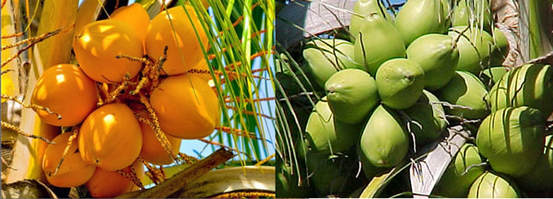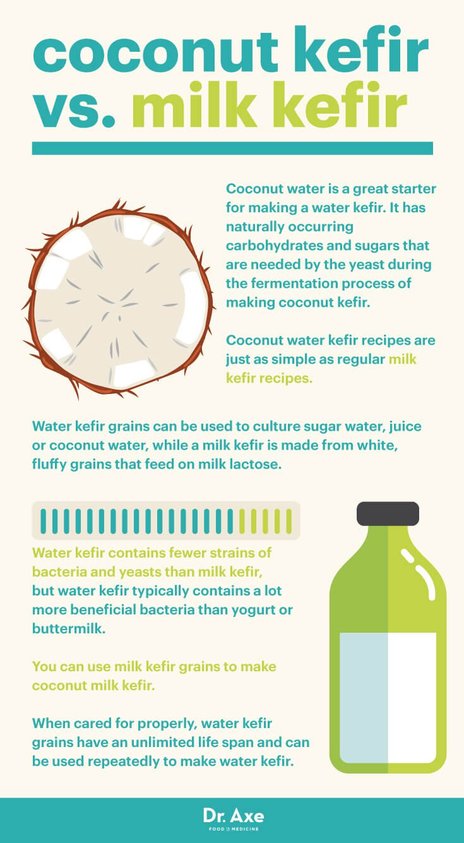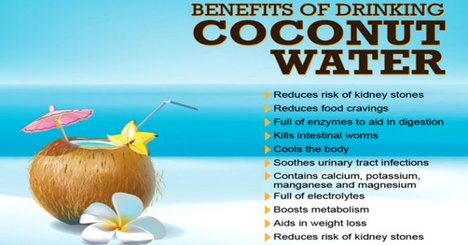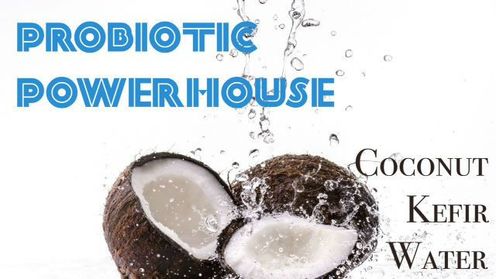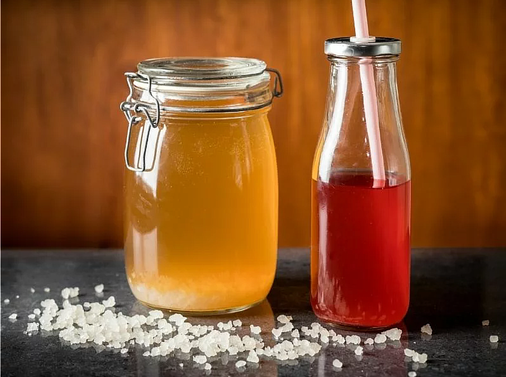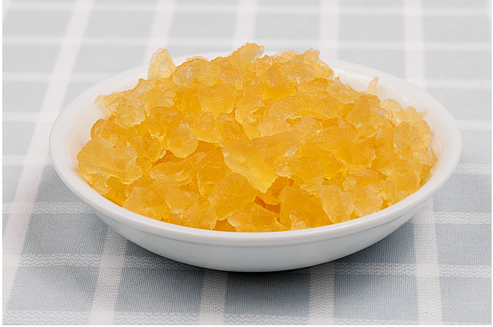🌸
Coconut and Water Kefir
🌸
Coconut and Water Kefir
🌸
🌸
Coconut Kefir
Coconut Milk Kefir
🌸
Coconut Kefir
Coconut Milk Kefir
🌸
I get asked a lot about dairy-free kefir options. I have seen some amazing results with kefir made from coconut, almond or walnut milk. I highly recommend these non-dairy milk kefirs if you want all of the benefits of kefir without the dairy.
Of these non-dairy milk kefirs, I have noticed that coconut kefir brings the best health results. Coconut milk has so many wonderful properties, including antifungal, antibacterial and antiviral properties. It is my favorite option for dairy-free kefir. However, every time I say something is my favorite, somewhere down the road I find another favorite. Do not be surprised if I change my mind.
Coconut kefir tends to be very thin and separates quite quickly when made according to the basic recipe. I found a way to make it a little bit creamier and the taste is supreme.
The secret is to add a little coconut spread. Coconut spread is made entirely from coconut meat. It is prepared by first drying coconut meat at low temperatures and then grinding it into a paste. You can find coconut spread at most health food stores or in my store.
Adding coconut spread to the coconut milk will give texture and extra flavor to the coconut kefir, but is not necessary to add and you can make it without it. I have tried just adding shredded coconut but it stuck to the kefir grains and then the kefir didn’t drain through the strainer. Coconut spread was a better option and the taste is wonderful.
Water kefir is another dairy-free alternative and many assume that this is the best dairy-free option but this is not true. Water kefir has smaller amounts of good bacteria compared with milk kefir, including dairy-free milk kefir. Water kefir has 10 probiotics while homemade milk kefir has anywhere between 30 and 50 probiotics.
I repeatedly see the greatest health benefits with dairy and nondairy milk kefirs, including the healing of food allergies and improved digestion. Water kefir is a still a good probiotic drink, but if you are looking for the most health benefits, I recommend choosing dairy or non-dairy milk kefir.
I have a new section entitled “Dairy-Free Options” on my website.
If you’re a Biotic Pro, you can also view the following lessons:
How to make coconut kefir cheese.
How to make coconut milk.
How to make coconut kefir.Creamy Coconut Kefir
You can use any kind of coconut milk or make your own.
When making non dairy kefir, you just need to be sure the non dairy milk has 8 grams of carbohydrates to give the bacteria something to eat.
It takes the sugars and makes it into probiotics for you. You don’t get the sugar but instead lots of healthy bacteria. If it doesn’t have 8 grams of carbohydrates than you can add 1 teaspoon of date paste, or raw sugar, per quart to give the bacteria food so it can make probiotics. I have placed the recommended amounts for coconut milk in the recipe below.~Donna
Non-Dairy Kefir using Easy Kefir
Non-Dairy Kefir using Live Kefir Grains
Servings: quart
Units:US ImperialMetric
Instructions
Non-Dairy Kefir using Easy Kefir
Non-Dairy Kefir using Live Milk Kefir Grains
This is best if made with the Easy Kefir packages. It can be made with kefir grains but the coconut tends to stick to the grains and can be hard to remove. Its creamier if you use Easy Kefir because you don't have to strain it and its a thicker product.
Original Title / My Coconut Kefir is Better Than Yours
CulturedFoodLife.com
Of these non-dairy milk kefirs, I have noticed that coconut kefir brings the best health results. Coconut milk has so many wonderful properties, including antifungal, antibacterial and antiviral properties. It is my favorite option for dairy-free kefir. However, every time I say something is my favorite, somewhere down the road I find another favorite. Do not be surprised if I change my mind.
Coconut kefir tends to be very thin and separates quite quickly when made according to the basic recipe. I found a way to make it a little bit creamier and the taste is supreme.
The secret is to add a little coconut spread. Coconut spread is made entirely from coconut meat. It is prepared by first drying coconut meat at low temperatures and then grinding it into a paste. You can find coconut spread at most health food stores or in my store.
Adding coconut spread to the coconut milk will give texture and extra flavor to the coconut kefir, but is not necessary to add and you can make it without it. I have tried just adding shredded coconut but it stuck to the kefir grains and then the kefir didn’t drain through the strainer. Coconut spread was a better option and the taste is wonderful.
Water kefir is another dairy-free alternative and many assume that this is the best dairy-free option but this is not true. Water kefir has smaller amounts of good bacteria compared with milk kefir, including dairy-free milk kefir. Water kefir has 10 probiotics while homemade milk kefir has anywhere between 30 and 50 probiotics.
I repeatedly see the greatest health benefits with dairy and nondairy milk kefirs, including the healing of food allergies and improved digestion. Water kefir is a still a good probiotic drink, but if you are looking for the most health benefits, I recommend choosing dairy or non-dairy milk kefir.
I have a new section entitled “Dairy-Free Options” on my website.
If you’re a Biotic Pro, you can also view the following lessons:
How to make coconut kefir cheese.
How to make coconut milk.
How to make coconut kefir.Creamy Coconut Kefir
You can use any kind of coconut milk or make your own.
When making non dairy kefir, you just need to be sure the non dairy milk has 8 grams of carbohydrates to give the bacteria something to eat.
It takes the sugars and makes it into probiotics for you. You don’t get the sugar but instead lots of healthy bacteria. If it doesn’t have 8 grams of carbohydrates than you can add 1 teaspoon of date paste, or raw sugar, per quart to give the bacteria food so it can make probiotics. I have placed the recommended amounts for coconut milk in the recipe below.~Donna
- Recipe Category Dairy Free Kefir, Gluten Free, Sugar Free
- Course Beverages, Breakfast
Non-Dairy Kefir using Easy Kefir
- 1packageEasy Kefir
- 3 - 3/4cupsCoconut Milk
- 1/2cupCoconut Spreador coconut cream
- 1teasponnDate Pasteor raw sugar
Non-Dairy Kefir using Live Kefir Grains
- 2 -3tablespoonsLive Kefir Grains
- 3 - 3/4cupsCoconut Milk
- 1/2cup Coconut Spreador coconut cream
- 1 teaspoon Date Pasteor raw sugar
Servings: quart
Units:US ImperialMetric
Instructions
Non-Dairy Kefir using Easy Kefir
- Place coconut milk, date paste and coconut spread into a blender and blend at high speed until well combined and the coconut spread is evenly distributed and finely ground.
- Place one package of Easy Kefir powder packets in a glass jar and fill the jar with fresh coconut milk from the blender.
- Place a lid or plastic wrap on the jar and let sit at room temperature for approx. 18 to 24 hours, or until the milk has thickened or has become sour to your liking.
- Place your kefir in the refrigerator or enjoy immediately. It should keep for at least a month or longer although it will continue to get more sour and tart.
- If you like to make more kefir, take 1/4 cup of this mixture and 3 -3/4 cups of fresh milk and culture again for 18-24 hours or until tart. You can do this many many times over or until it stops working and making the milk tart. Then you will need a new Easy Kefir powder packet.
Non-Dairy Kefir using Live Milk Kefir Grains
- Place coconut milk and coconut spread and date paste into a blender and blend at high speed until well combined and the coconut spread is evenly distributed and finely ground.
- Then add the kefir grains.
- Place a lid on it and let it ferment until tart and sour about 18 -24 hours.
- Remove the grains by straining and place in fresh milk with another spoonful of date paste. Repeat to keep your grains alive. The coconut might stick to the kefir grains but they don't hurt anything if they do.
- Place kefir in the refrigerator or enjoy immediately. It should keep for at least a month although it will continue to get more sour and tart.
This is best if made with the Easy Kefir packages. It can be made with kefir grains but the coconut tends to stick to the grains and can be hard to remove. Its creamier if you use Easy Kefir because you don't have to strain it and its a thicker product.
Original Title / My Coconut Kefir is Better Than Yours
CulturedFoodLife.com
🌸
🌸
🌸
Why You Should Try Coconut Kefir,
The Wonder Elixir
🌸
Why You Should Try Coconut Kefir,
The Wonder Elixir
🌸
http://www.onegreenplanet.org/vegan-food/why-you-should-try-coconut-kefir-the-wonder-elixer/
Though it’s considered a tropical food, coconut has become more mainstream than ever, enjoyed by people that previously only related this food to exotic islands far, far away. We’ve also come a long way in how we enjoy coconut.
What was once consumed as a bag of sugary, sweetened shredded coconut used on cakes and in unhealthy desserts (hello Mounds bars!), we’re now enjoying coconut butter, raw coconut cream, coconut oil, coconut flour, coconut milk, and unsweetened shredded coconut and coconut flakes.
But beyond these healthier forms of coconut, lies a magical form that many other people don’t know about or even think to consider using in their daily routines.
Coconut kefir is a beverage that’s becoming more and more popular due to its incredible health benefits, for everything such as boosting immunity to fighting off harmful yeasts and bacteria. While kombucha brought back the hip factor to the world of fermented foods, coconut kefir is taking the reigns pretty quickly.
Why Plant-Based Fermented Foods Like Coconut Kefir Are Important
First, before you consider using coconut kefir, you should know why fermented and cultured foods are important. We have more bacteria cultures in our body than we do human cells. We’re more composed of bacteria than anything else, and within our bodies lies both good bacteria and bad bacteria. You’ll never be completely free of bad bacteria; that’s just part of how the human body works. But what you do want to make sure is, that you have more good bacteria than bad bacteria.
When bad bacteria (such as yeasts, viruses, fungi, etc.) outweigh the good kind (probiotics and prebiotics), you get sick, develop yeast infections, fungal overgrowth and have symptoms like acne, jock itch, the cold, the flu, have chronic digestive complains, a number of food allergies, food cravings, weight gain, and can even develop depression since good gut bacteria directly influence brain health.
Fermented foods like cultured veggies, yogurt, kombucha, kefir, chocolate, and pickles all contain natural sources of probiotics. You can also take a probiotic supplement and eat prebiotics (such as onions, asparagus, garlic, bananas, and others) that feed good gut bacteria.
Antibiotics, pesticides, eating animal foods treated with hormones and chemicals, stress, contact with fungi, viruses, and harmful yeasts, all lower our body’s good gut bacteria. But don’t reach for that Yoplait or Dannon yogurt just yet – dairy is not the best option when it comes to taking care of your gut. What is?
Coconut kefir.
How Coconut Kefir Can Help and What It’s All About:
Coconut water kefir is made from coconut water. It’s a fermented beverage made from kefir ‘grains’ which are highly beneficial organisms of bacteria that promote good digestion, gut health, immunity, and even enhance the brain and mood. Kefir is usually made with dairy milk since the sugars in milk (lactose) feed the good bacteria needed for growth.
Dairy kefir is often prized for its health benefits, but the kefir is where the real magic happens- not the cow’s milk it’s cultured in. Since dairy isn’t the most health-promoting choice out there, it’s best to try to find an ulterior medium to culture good bacteria (such as kefir grains) with. Coconut water has natural sugars that happen to feed kefir grains just as much as lactose does, but without all the negative side effects that come with dairy.
How is Coconut Kefir Special?
Coconut on its own as a whole food promotes a healthy immune system, contains antiviral properties, and has been shown to boost liver and brain health. When the water or milk from coconut is cultured with kefir grains to make coconut kefir, the benefits skyrocket. Coconut water kefir contains more beneficial strains and organisms than dairy-based kefir, or any kind of yogurt. Yogurt doesn’t colonize good bacteria in the digestive system, but kefir does.
Coconut water kefir is also lower in calories than dairy forms, has no fat or sugar, and is much more palatable! It’s been shown to help the following: cleanse the body, enhance digestion of all foods, flatten the stomach, promote a better mood, balance hormones, increase your energy, eliminate Candida (a harmful yeast), stop the growth of stomach cancer cells, and even stop cravings for sugar.
Buy It or Make It: How to Get Your Hands On This Magical Elixer
You can buy coconut kefir at any health food store like Whole Foods. It’s found in the section with the probiotics and will be refrigerated. It can be pricey but most bottles contain around 30 servings and you’ll only need a tablespoon a day to get the benefits.
Or, for those of you that are crafty in the kitchen, you can make your own (no cow needed here!)
To make your own coconut kefir, follow these easy directions below:
1. First, cut open your coconut, you’ll need a cleaver or a large knife. After cutting the coconut open, you’ll need the water to make your kefir and can scrape out the meat (coconut butter) to use for smoothies, desserts, or just eat it off the spoon!
2. To make your kefir, in a blender, blend 1 serving of purchased kefir grains or 1 tablespoon of store bought coconut kefir with the coconut water.
3. Blend for 30 seconds enough to warm up the mixture slightly. High-powered blenders will do this more efficiently than other blenders, but most blenders will start to warm up just a bit within 30-60 seconds. (Just make sure the lid is on good!)
4. Once blended, pour the mixture into a large, sterilized glass bowl, or even a clean, slow-cooker pot insert. You just want something glass, not plastic which will be non-toxic.
5. Wrap the bowl or pot with a large towel. Make sure it’s covered very well, and then place it in a cool oven to sit at least 1-2 days. Keeping it in the oven ensures no air drafts will disrupt the fermentation process. In a day or so, check your kefir (sorry but no, you can’t use the oven during this time). It should smell soured but not spoiled (much like yogurt smells). The concoction should be a bit bubbly, which means it’s alive and working!
6. After 24 hours, go ahead and transfer the liquid to a glass pitcher container for storage in your fridge. Or you can let it ferment longer for another 24 hours if you don’t feel it smells “just right.” Again, it should smell like yogurt or store bought kefir.
How to Use Coconut Kefir
You can use coconut water kefir in smoothies, or just have a tablespoon or two in the morning in some water with lemon and stevia for a better flavor, or just stir it into overnight oats. Don’t add it to hot beverages like tea and coffee since high heat destroys the probiotics.
Coconut water kefir and other naturally fermented foods are important to add to your diet to maintain good health. After all, you gotta take care of all those good bacteria so they can take care of you!
Try some of our other healthy fermented recipes here at One Green Planet such as:
Image Source: Cara Faus/Flickr
Want to read more posts like this? Sign up for our newsletter below!
Feel Years Younger By Boosting Your Stem Cells At HomeLCR Health Supplements
Constant Fatigue Is A Warning Sign – See The Simple FixGundry MD
Though it’s considered a tropical food, coconut has become more mainstream than ever, enjoyed by people that previously only related this food to exotic islands far, far away. We’ve also come a long way in how we enjoy coconut.
What was once consumed as a bag of sugary, sweetened shredded coconut used on cakes and in unhealthy desserts (hello Mounds bars!), we’re now enjoying coconut butter, raw coconut cream, coconut oil, coconut flour, coconut milk, and unsweetened shredded coconut and coconut flakes.
But beyond these healthier forms of coconut, lies a magical form that many other people don’t know about or even think to consider using in their daily routines.
Coconut kefir is a beverage that’s becoming more and more popular due to its incredible health benefits, for everything such as boosting immunity to fighting off harmful yeasts and bacteria. While kombucha brought back the hip factor to the world of fermented foods, coconut kefir is taking the reigns pretty quickly.
Why Plant-Based Fermented Foods Like Coconut Kefir Are Important
First, before you consider using coconut kefir, you should know why fermented and cultured foods are important. We have more bacteria cultures in our body than we do human cells. We’re more composed of bacteria than anything else, and within our bodies lies both good bacteria and bad bacteria. You’ll never be completely free of bad bacteria; that’s just part of how the human body works. But what you do want to make sure is, that you have more good bacteria than bad bacteria.
When bad bacteria (such as yeasts, viruses, fungi, etc.) outweigh the good kind (probiotics and prebiotics), you get sick, develop yeast infections, fungal overgrowth and have symptoms like acne, jock itch, the cold, the flu, have chronic digestive complains, a number of food allergies, food cravings, weight gain, and can even develop depression since good gut bacteria directly influence brain health.
Fermented foods like cultured veggies, yogurt, kombucha, kefir, chocolate, and pickles all contain natural sources of probiotics. You can also take a probiotic supplement and eat prebiotics (such as onions, asparagus, garlic, bananas, and others) that feed good gut bacteria.
Antibiotics, pesticides, eating animal foods treated with hormones and chemicals, stress, contact with fungi, viruses, and harmful yeasts, all lower our body’s good gut bacteria. But don’t reach for that Yoplait or Dannon yogurt just yet – dairy is not the best option when it comes to taking care of your gut. What is?
Coconut kefir.
How Coconut Kefir Can Help and What It’s All About:
Coconut water kefir is made from coconut water. It’s a fermented beverage made from kefir ‘grains’ which are highly beneficial organisms of bacteria that promote good digestion, gut health, immunity, and even enhance the brain and mood. Kefir is usually made with dairy milk since the sugars in milk (lactose) feed the good bacteria needed for growth.
Dairy kefir is often prized for its health benefits, but the kefir is where the real magic happens- not the cow’s milk it’s cultured in. Since dairy isn’t the most health-promoting choice out there, it’s best to try to find an ulterior medium to culture good bacteria (such as kefir grains) with. Coconut water has natural sugars that happen to feed kefir grains just as much as lactose does, but without all the negative side effects that come with dairy.
How is Coconut Kefir Special?
Coconut on its own as a whole food promotes a healthy immune system, contains antiviral properties, and has been shown to boost liver and brain health. When the water or milk from coconut is cultured with kefir grains to make coconut kefir, the benefits skyrocket. Coconut water kefir contains more beneficial strains and organisms than dairy-based kefir, or any kind of yogurt. Yogurt doesn’t colonize good bacteria in the digestive system, but kefir does.
Coconut water kefir is also lower in calories than dairy forms, has no fat or sugar, and is much more palatable! It’s been shown to help the following: cleanse the body, enhance digestion of all foods, flatten the stomach, promote a better mood, balance hormones, increase your energy, eliminate Candida (a harmful yeast), stop the growth of stomach cancer cells, and even stop cravings for sugar.
Buy It or Make It: How to Get Your Hands On This Magical Elixer
You can buy coconut kefir at any health food store like Whole Foods. It’s found in the section with the probiotics and will be refrigerated. It can be pricey but most bottles contain around 30 servings and you’ll only need a tablespoon a day to get the benefits.
Or, for those of you that are crafty in the kitchen, you can make your own (no cow needed here!)
- All you need to do is purchase water kefir grains, which you can purchase online, or you can use store bought coconut kefir to act as a starter culture.
- After you have your culture starter, you’ll need a whole coconut so you can use the fresh milk or water from a coconut. Buy a young (white) coconut, not the mature brown ones which are often lower in nutrients and may even be spoiled. Don’t use bottled coconut water since it is lacking in the true health benefits whole coconuts contain.
To make your own coconut kefir, follow these easy directions below:
1. First, cut open your coconut, you’ll need a cleaver or a large knife. After cutting the coconut open, you’ll need the water to make your kefir and can scrape out the meat (coconut butter) to use for smoothies, desserts, or just eat it off the spoon!
2. To make your kefir, in a blender, blend 1 serving of purchased kefir grains or 1 tablespoon of store bought coconut kefir with the coconut water.
3. Blend for 30 seconds enough to warm up the mixture slightly. High-powered blenders will do this more efficiently than other blenders, but most blenders will start to warm up just a bit within 30-60 seconds. (Just make sure the lid is on good!)
4. Once blended, pour the mixture into a large, sterilized glass bowl, or even a clean, slow-cooker pot insert. You just want something glass, not plastic which will be non-toxic.
5. Wrap the bowl or pot with a large towel. Make sure it’s covered very well, and then place it in a cool oven to sit at least 1-2 days. Keeping it in the oven ensures no air drafts will disrupt the fermentation process. In a day or so, check your kefir (sorry but no, you can’t use the oven during this time). It should smell soured but not spoiled (much like yogurt smells). The concoction should be a bit bubbly, which means it’s alive and working!
6. After 24 hours, go ahead and transfer the liquid to a glass pitcher container for storage in your fridge. Or you can let it ferment longer for another 24 hours if you don’t feel it smells “just right.” Again, it should smell like yogurt or store bought kefir.
How to Use Coconut Kefir
You can use coconut water kefir in smoothies, or just have a tablespoon or two in the morning in some water with lemon and stevia for a better flavor, or just stir it into overnight oats. Don’t add it to hot beverages like tea and coffee since high heat destroys the probiotics.
Coconut water kefir and other naturally fermented foods are important to add to your diet to maintain good health. After all, you gotta take care of all those good bacteria so they can take care of you!
Try some of our other healthy fermented recipes here at One Green Planet such as:
- Kimchi: The Next Superfood
- All About Plant-Based Probiotics: Get Them First Thing in the Morning!
- How to Make Your Own Coconut Yogurt
Image Source: Cara Faus/Flickr
Want to read more posts like this? Sign up for our newsletter below!
Feel Years Younger By Boosting Your Stem Cells At HomeLCR Health Supplements
Constant Fatigue Is A Warning Sign – See The Simple FixGundry MD
🌸
🌸
🌸
WATER KEFIR
🌸
WATER KEFIR
🌸
🌸
https://www.fusionteas.com/fresh-water-kefir-grains-crystals/?sku=WKG-4TBS&gad_source=1&gclid=Cj0KCQiA84CvBhCaARIsAMkAvkJv1LsH8ReioJpxcSC3btaEojtLIbJ7B0CL7OdWpsT764y_ALG9vzAaAs_dEALw_wcB
🌸
https://revolutionfermentation.com/en/blogs/water-kefir/5-scientific-benefits-of-water-kefir/#:~:text=Water%20Kefir%20Is%20Rich%20in%20Probiotics&text=Studies%20show%20that%20a%20250,billion%20good%20microorganisms%20(ref).
🌸
https://www.fusionteas.com/fresh-water-kefir-grains-crystals/?sku=WKG-4TBS&gad_source=1&gclid=Cj0KCQiA84CvBhCaARIsAMkAvkJv1LsH8ReioJpxcSC3btaEojtLIbJ7B0CL7OdWpsT764y_ALG9vzAaAs_dEALw_wcB
🌸
https://revolutionfermentation.com/en/blogs/water-kefir/5-scientific-benefits-of-water-kefir/#:~:text=Water%20Kefir%20Is%20Rich%20in%20Probiotics&text=Studies%20show%20that%20a%20250,billion%20good%20microorganisms%20(ref).
🌸
🌸


